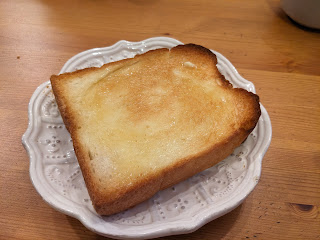I’ve said it before (somewhere) that everything the Japanese do, they do it with care, attention, pride and most importantly of all, craft. People strive to find perfection and once found there is additional pride in executing a task perfectly. This applies to everything. From a safety check before a train driver to the way a parking attendant waves his flag, to the technique you would use to proof and knead dough at a bakery. The Japanese name for a master in this is ‘Takomi’
With that in mind Let's talk about food in Japan.
And I’d like to start with the best example olf the above statement I can think of: Toast.
 |
Yes, toast. Plain white bread toast.
This is quite possibly the best slice of toast I’ve ever eaten.Its thick, but light and fluffy, perfectly textured and dreamy in taste. I don’t know what, exactly, they do to white bread here (although I plan to find out as I make bread at home every week).
it's not uncommon to seek out a bakery just for a specific item. I often did that when I lived here. A shop might literally make a single item. but make it perfectly (of course). Different places have different specialties - breads, pastries, rolls, buns, sandwiches.
Now we may scoff at this in the west. After all, we can buy tasteless spongey sandwich sliced loaves anywhere in the western world - even at a gas station. But this ain’t that. this is… white bread perfection.
Trust me, don’t knock it till you try it.
Of all things japanese that are presented to you has a visitor, food here is often the most different from other cultures, either visually or by taste - but often both at the same time.. Sure we are all familiar with Sushi (or at least the pitiful version we are often passed off with in our own countries) and Ramen is indeed popular around the world, but there is so much more, many of which you can’t experience easily outside of Japan.
One example of this is Soup-Curry. This is a dish that originates in the Hokkaido Region and has roots in Indian Curry in terms of flavours and spices, but is as liquidy and thin as a consume and bares little visual resemblance to the cuisine of western asia. It uses more local vegetables like sweet potatoes, carrots and broccoli in its base, along with mincemeat, chicken and shrimps. I should add that it can also be extremely hot. Sometimes much hotter than anything you’d be served in india and the relatively few places that specialise it often offer a heat chart ranging from 1 to 100 for you to choose your desired spice level. I’ve never gone over 50 I’d I’d out myself in the top 5 percentile in the world of being able to eat hot food (thats not a fanciful claim, I have proved it and its documented).
I first tried it on my last visit in 2016, at a small backstreet place in Yokohama. when I lived here prior to that it hadn’t really gained popularity outside of its native Hokkaido. This is a relatively new food phenomena, such that I wouldn’t even call it a craze… yet.
This time we decided to do a take out from a newish joint that has opened up in Izumi, Sendai called XXXX. We ordered online and picked up a huge array of soups and rice sides (everyone in the swan family wanted something different and at a different spice level)
I went for a chicken coriander soup, with a separate yellow rice side. When I tried it previously it was just soup (and I seem to remember that their may have been a noodle side). Heat level was only 25 as they wouldn't / couldn’t do that dish at a higher level. And trust me, there was no need. it was precisely the level of heat your want with those flavours. not to hot, but a good kick. It was fantastic.
I really hope this is a food trend that spreads beyond these lands!
Earlier that day we had more traditional sushi. We'd been to visit Luke's Parents Cabin, which he now rents out as a holiday home. On the way there and While he was prepping the place, he explained to me the impact that the 2011 Tsunami had had on that area.
This was one of the places along the Sendai coast where the Tsunami had made landfall in full force and had been totally ravaged. His parents house was up high on a cliff, but nearly everything below had been wiped out. where there were now verdant luch green fields were once densely packed streets of houses.
From the front porch you could see the newly built Tsunami wall. and beyond it some of the green area that had previously been built up and urbanised.
Standing there and realising how much had been wiped out and the power of that force of nature is quite humbling not to mention upsetting and sad.
On our way back to Sendai we stopped at a sushi restaurant. needless to say the food was amazing - Red Snapper, Tuna, Octopus, Wasabi rolls, British Columbia rolls and Fatty Salmon. I’m going to let the movies I took of the arrival of the food speak about the experience.





No comments:
Post a Comment